Subaru Forester 2020 Owner's Manual

Foreword
Foreword
SFWAA
Congratulations on choosing a SUBARU vehicle. This Owner’s Manual has all the information necessary to keep your SUBARU in excellent condition and to properly maintain the emission control system for minimizing emission pollutants. We urge you to read this manual carefully so that you may understand your vehicle and its operation. For information not found in this Owner’s Manual, such as details concerning repairs or adjustments, please contact the SUBARU dealer from whom you purchased your SUBARU or the nearest SUBARU dealer.
The information, specifications and illustrations found in this manual are those in effect at the time of printing. SUBARU CORPORATION reserves the right to change specifications and designs at any time without prior notice and without incurring any obligation to make the same or similar changes on vehicles previously sold. This Owner’s Manual applies to all models and covers all equipment, including factory installed options. Some explanations, therefore may be for equipment not installed in your vehicle.
Please leave this manual in the vehicle at the time of resale. The next owner will need the information found herein.
SUBARU CORPORATION, TOKYO, JAPAN
“SUBARU” and the six–star cluster design are registered trademarks of SUBARU CORPORATION.
*C Copyright 2019 SUBARU CORPORATION
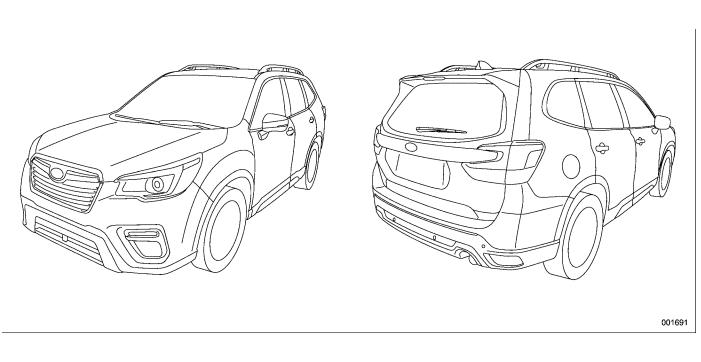
Vehicle types
SFWAB
This manual describes the following vehicle types.

S00
Warranties
S00AA
& Warranties for U.S.A.
S00AA01
SUBARU vehicles distributed by Subaru of America, Inc. and sold at retail by an authorized SUBARU dealer in the United States come with the following warranties:
. SUBARU Limited Warranties
. Federal Emission Control Systems
Warranties
. California Emissions Control Systems Warranties
All warranty information, including applicability, details of coverage and exclusions, is in the “Warranty and Maintenance Booklet”. Read these warranties carefully.
& Warranties for Canada
S00AA05
SUBARU vehicles distributed by Subaru Canada, Inc. and sold at retail by an authorized SUBARU dealer in Canada come with the following warranties:
. SUBARU Limited Warranty
. Emission Control System Warranty
All warranty information, including applicability, details of coverage and exclusions, is in the “Warranty and Service Booklet”. Read these warranties carefully.
&Warranties except for U.S.A. and Canada
S00AA06
All warranty information, including details of coverage and exclusions, is in the “Warranty and Maintenance Booklet”. Read these warranties carefully.
1
How to use this Owner’s Manual
S00AB
& Using your Owner’s Manual
S00AB01
Before you operate your vehicle, carefully read this manual. To protect yourself and extend the service life of your vehicle, follow the instructions in this manual. Failure to observe these instructions may result in serious injury and damage to your vehicle.
This manual is composed of fourteen chapters. Each chapter begins with a brief table of contents, so you can usually tell at a glance if that chapter contains the information you want.
Chapter 1: Seat, seatbelt and SRS airbags
This chapter informs you how to use the seat and seatbelt and contains precautions for the SRS airbags.
Chapter 2: Keys and doors
This chapter informs you how to operate the keys, locks and windows.
Chapter 3: Instruments and controls
This chapter informs you about the operation of instrument panel indicators and how to use the instruments and other switches.
– CONTINUED –

2
Chapter 4: Climate control
This chapter informs you how to operate the climate control.
Chapter 5: Audio
This chapter informs you about your audio system.
Chapter 6: Interior equipment
This chapter informs you how to operate interior equipment.
Chapter 7: Starting and operating
This chapter informs you how to start and operate your SUBARU.
Chapter 8: Driving tips
This chapter informs you how to drive your SUBARU in various conditions and explains some safety tips on driving.
Chapter 9: In case of emergency
This chapter informs you what to do if you have a problem, such as a flat tire or engine overheating.
Chapter 10: Appearance care
This chapter informs you how to keep your SUBARU looking good.
Chapter 11: Maintenance and service
This chapter informs you when you need to take your SUBARU to the dealer for scheduled maintenance and informs you how to keep your SUBARU running properly.
Chapter 12: Specifications
This chapter informs you about dimensions and capacities of your SUBARU.
Chapter 13: Consumer information and reporting safety defects
This chapter informs you about Uniform tire quality grading standards and Reporting safety defects.
Chapter 14: Index
This is an alphabetical listing of all that’s in this manual. You can use it to quickly find something you want to read.
For models with EyeSight system:
For details about the EyeSight system, refer to the Owner’s Manual supplement for the EyeSight system.
& Safety warnings
S00AB02
You will find a number of WARNINGs, CAUTIONs and NOTEs in this manual. These safety warnings alert you to potential hazards that could result in injury to you or others.
Please read these safety warnings as well as all other portions of this manual carefully in order to gain a better understanding of how to use your SUBARU vehicle safely.
 WARNING
WARNING
A WARNING indicates a situation in which serious injury or death could result if the warning is ignored.
 CAUTION
CAUTION
A CAUTION indicates a situation in which injury or damage to your vehicle, or both, could result if the caution is ignored.
NOTE
A NOTE gives information or suggestions how to make better use of your vehicle.
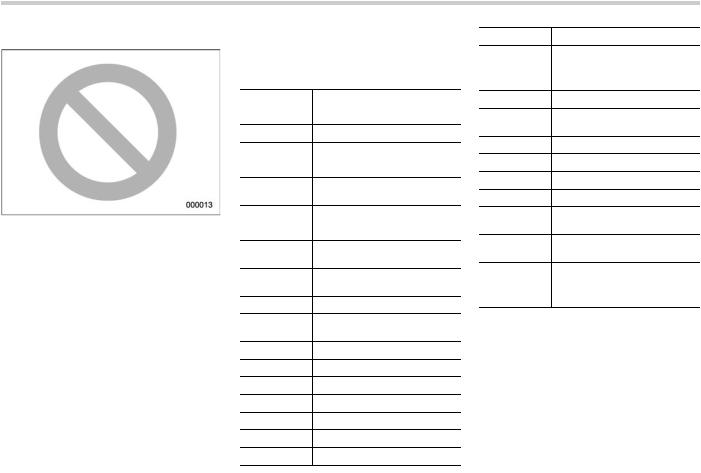

4
Vehicle symbols
S00AC
There are some of the symbols you may see on your vehicle.
For warning and indicator lights, refer to “Warning and indicator lights” FP24.
Mark Name
WARNING
CAUTION
Read these instructions carefully
Wear eye protection
Battery fluid contains sulfuric acid
Keep children away
Keep flames away
Prevent explosions
Safety precautions when driving
S00AD
& Seatbelt and SRS airbag
S00AD01
 WARNING
WARNING
.All persons in the vehicle must fasten their seatbelts BEFORE the vehicle starts to move. Otherwise, the possibility of serious injury becomes greater in the event of a sudden stop or accident.
.To obtain maximum protection in the event of an accident, the driver and all passengers must always wear seatbelts when in the vehicle. The SRS (Supplemental Restraint System) airbag does not do away with the need to fasten seatbelts. In combination with the seatbelts, it offers the best combined protection in case of a serious accident.
Not wearing a seatbelt increases the chance of severe injury or death in a crash even when the vehicle has the SRS airbag.
.The SRS airbags deploy with considerable speed and force. Occupants who are out of the proper position when the SRS airbag deploys could suffer very serious injuries. Because the SRS airbag needs enough space for deployment, the driver should always sit upright and well back in the seat as far from the steering wheel as practical while still maintaining full vehicle control and the front passenger should move the seat as far back as possible and sit upright and well back in the seat.
For instructions and precautions, carefully read the following sections.
. For the seatbelt system, refer to “Seatbelts” FP49.
. For the SRS airbag system, refer to “SRS airbag (Supplemental Restraint System airbag)” FP75.

& Child safety
S00AD02
 WARNING
WARNING
.Never hold a child on your lap or in your arms while the vehicle is moving. The passenger cannot protect the child from injury in a collision, because the child will be caught between the passenger and objects inside the vehicle.
.While riding in the vehicle, infants and small children should always be seated in the REAR seat in an infant or child restraint system which is appropriate for the child’s age, height and weight. If a child is too big for a child restraint system, the child should sit in the REAR seat and be restrained using the seatbelts. According to accident statistics, children are safer when properly restrained in the rear seating positions than in the front seating positions. Never allow a child to stand up or kneel on the seat.
.Place children in the REAR seat properly restrained at all times in a child restraint device or in a seatbelt. The SRS airbag deploys
with considerable speed and force and can injure or even kill children, especially if they are not restrained or improperly restrained. Because children are lighter and weaker than adults, their risk of being injured from deployment is greater.
.NEVER INSTALL A CHILD SEAT IN THE FRONT SEAT. DOING SO RISKS SERIOUS INJURY OR DEATH TO THE CHILD BY PLACING THE CHILD’S HEAD TOO CLOSE TO THE SRS AIRBAG.
.Always turn the child safety locks to the “LOCK” position when children sit in the rear seat. Serious injury could result if a child accidentally opens the door and falls out. Refer to “Child safety locks” FP139.
.Always lock the passenger’s windows using the lock switch when children are riding in the vehicle. Failure to follow this procedure could result in injury to a child operating the power window. Refer to “Windows” FP140.
.Never leave unattended children, adults or animals in the vehicle. They could accidentally injure
5
themselves or others through inadvertent operation of the vehicle. Also, on hot or sunny days, temperature in a closed vehicle could quickly become high enough to cause severe or possibly fatal injuries to them.
.When leaving the vehicle, close all windows and lock all doors.
For instructions and precautions, carefully read the following sections.
. For the seatbelt system, refer to “Seatbelts” FP49.
. For the child restraint system, refer to “Child restraint systems” FP61.
. For the SRS airbag system, refer to “SRS airbag (Supplemental Restraint System airbag)” FP75.
– CONTINUED –

6
&Engine exhaust gas (carbon monoxide)
S00AD03
 WARNING
WARNING
.Never inhale engine exhaust gas. Engine exhaust gas contains carbon monoxide, a colorless and odorless gas which is dangerous, or even lethal, if inhaled.
.Always properly maintain the engine exhaust system to prevent engine exhaust gas from entering the vehicle.
.Never run the engine in a closed space, such as a garage, except for the brief time needed to drive the vehicle in or out of it.
.Avoid remaining in a parked vehicle for a lengthy time while the engine is running. If that is unavoidable, then use the ventilation fan to force fresh air into the vehicle.
.Always keep the front ventilator inlet grille free from snow, leaves or other obstructions to ensure that the ventilation system always works properly.
.If at any time you suspect that exhaust fumes are entering the
vehicle, have the problem checked and corrected as soon as possible. If you must drive under these conditions, drive only with all windows fully open.
.Keep the rear gate closed while driving to prevent exhaust gas from entering the vehicle.
& Drinking and driving
S00AD04
 WARNING
WARNING
Drinking and then driving is very dangerous. Alcohol in the bloodstream delays your reaction time and impairs your perception, judgment and attentiveness. If you drive after drinking – even if you drink just a little – it will increase the risk of being involved in a serious or fatal accident, injuring or killing yourself, your passengers and others. In addition, if you are injured in the accident, alcohol may increase the severity of that injury.
Please don’t drink and drive.
Drunken driving is one of the most frequent causes of accidents. Since alcohol affects all people differently, you may have con-
sumed too much alcohol to drive safely even if the level of alcohol in your blood is below the legal limit. The safest thing you can do is never drink and drive. However if you have no choice but to drive, stop drinking and sober up completely before getting behind the wheel.
& Drugs and driving
S00AD05
 WARNING
WARNING
There are some drugs (over the counter and prescription) that can delay your reaction time and impair your perception, judgment and attentiveness. If you drive after taking them, it may increase your, your passengers’ and other persons’ risk of being involved in a serious or fatal accident.
If you are taking any drugs, check with your doctor or pharmacist or read the literature that accompanies the medication to determine if the drug you are taking can impair your driving ability. Do not drive after taking any medications that can make you drowsy or otherwise affect your ability to safely operate a motor vehicle. If you have a medical condition that requires you to take drugs, please consult with your doctor.
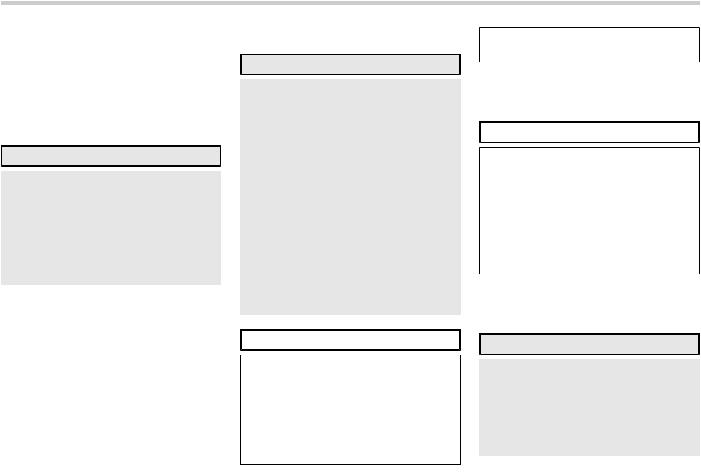
Never drive if you are under the influence of any illicit mind-altering drugs. For your own health and well-being, we urge you not to take illegal drugs in the first place and to seek treatment if you are addicted to those drugs.
& Driving when tired or sleepy
S00AD06
 WARNING
WARNING
When you are tired or sleepy, your reaction time will be delayed and your perception, judgment and attentiveness will be impaired. If you drive when tired or sleepy, your, your passengers’ and other persons’ chances of being involved in a serious accident may increase.
Please do not continue to drive but instead find a safe place to rest if you are tired or sleepy. On long trips, you should make periodic rest stops to refresh yourself before continuing on your journey. When possible, you should share the driving with others.
& Modification of your vehicle
S00AD07
 WARNING
WARNING
.Do not remove the SUBARU genuine navigation and/or audio system. If the SUBARU genuine navigation and/or audio system is removed, the rear view camera image and help lines (distance marker, dynamic guidelines and vehicle width lines) will no longer be displayed.
.For some models with Reverse Automatic Braking, even if the Reverse Automatic Braking and object detection warning is ON, the visible alert of Reverse Automatic Braking will not be displayed. However, the audible alert and its function will operate.
 CAUTION
CAUTION
Your vehicle should not be modified other than with genuine SUBARU parts and accessories. Other types of modifications could affect its performance, safety or durability, and may even violate governmental regulations. In addition, damage or performance problems resulting
7
from modification may not be covered under warranties.
&Use of cell phones/texting and driving
S00AD16
 CAUTION
CAUTION
Do not talk on a cell phone or text while driving; it may distract your attention from driving and lead to an accident. If you use a cell phone to talk or text, first pull off the road and park in a safe place. In some States/ Provinces, it may be lawful to talk on a phone while driving, but only if the phone is hands-free.
&Driving vehicles equipped with navigation system
S00AD09
 WARNING
WARNING
Do not allow the monitor to distract your attention from driving. Also, do not operate the controls of the navigation system while driving. The loss of attention to driving could lead to an accident. If you wish to operate the controls of the naviga-
– CONTINUED –

8
tion system, first take the vehicle off the road and stop it in a safe location.
& Driving with pets
S00AD10
Unrestrained pets can interfere with your driving and distract your attention from driving. In a collision or sudden stop, unrestrained pets or cages can be thrown around inside the vehicle and hurt you or your passengers. Besides, the pets can be hurt under these situations. It is also for their own safety that pets should be properly restrained in your vehicle. Restrain a pet with a special traveling harness which can be secured to the rear seat with a seatbelt or use a pet carrier which can be secured to the rear seat by routing a seatbelt through the carrier’s handle. Never restrain pets or pet carriers in the front passenger’s seat. For further information, consult your veterinarian, local animal protection society or pet shop.
& Tire pressures
S00AD11
Check and, if necessary, adjust the pressure of each tire and the spare (if equipped) at least once a month and before any long journey.
Check the tire pressure when the tires are
cold. Use a pressure gauge to adjust the tire pressures to the values shown on the tire placard. For detailed information, refer to “Tires and wheels” FP467.
 WARNING
WARNING
Driving at high speeds with excessively low tire pressures can cause the tires to deform severely and to rapidly become hot. A sharp increase in temperature could cause tread separation, and destruction of the tires. The resulting loss of vehicle control could lead to an accident.
& Attaching accessories
S00AD15
 WARNING
WARNING
.Do not attach any accessories, labels or stickers (other than properly placed inspection stickers) to the windshield. Such items may obstruct your view.
.If it is necessary to attach an accessory (such as an electronic toll collection (ETC) device or
security pass) to the windshield, consult your SUBARU dealer for details on the proper location.

9
General information
S00AK
&California Perchlorate Advisory
S00AK03
Certain vehicle components, such as airbag modules, seatbelt pretensioners and keyless entry transmitter batteries, may contain perchlorate material. Special handling may apply for service or vehicle end of life disposal. See www.dtsc.ca.gov/ hazardouswaste/perchlorate.
& Noise from under the vehicle
S00AK01
NOTE
You may hear a noise from under the vehicle approximately 5 to 10 hours after the ignition switch is turned to the “LOCK”/“OFF” position. However, this does not indicate a malfunction. This noise is caused by the operation of the fuel evaporation leakage checking system and the operation is normal. The noise will stop after approximately 15 minutes.
& Event data recorder
S00AK04
This vehicle is equipped with an event data recorder (EDR). The main purpose of an EDR is to record, in certain crash or near crash-like situations, such as an air bag
deployment or hitting a road obstacle, data that will assist in understanding how a vehicle’s systems performed. The EDR is designed to record data related to vehicle dynamics and safety systems for a short period of time, typically 30 seconds or less. The EDR in this vehicle is designed to record such data as:
. How various systems in your vehicle were operating;
. Whether or not the driver and passenger safety belts were buckled/fastened;
. How far (if at all) the driver was depressing the accelerator and/or brake pedal; and,
. How fast the vehicle was traveling.
These data can help provide a better understanding of the circumstances in which crashes and injuries occur. NOTE: EDR data are recorded by your vehicle only if a non-trivial crash situation occurs; no data are recorded by the EDR under normal driving conditions and no personal data (e.g., name, gender, age, and crash location) are recorded. However, other parties, such as law enforcement, could combine the EDR data with the type of personally identifying data routinely acquired during a crash investigation.
To read data recorded by an EDR, special equipment is required, and access to the
vehicle or the EDR is needed. In addition to the vehicle manufacturer, other parties, such as law enforcement, that have the special equipment, can read the information if they have access to the vehicle or the EDR.

—— — — — — — — — — — — — — — — — — — — — — — — — — — — — — — — — — — — — — — —
—— — — — — — — — — — — — — — — — — — — — — — — — — — — — — — — — — — — — — — —
—— — — — — — — — — — — — — — — — — — — — — — — — — — — — — — — — — — — — — — —
—— — — — — — — — — — — — — — — — — — — — — — — — — — — — — — — — — — — — — — —
—— — — — — — — — — — — — — — — — — — — — — — — — — — — — — — — — — — — — — — —
—— — — — — — — — — — — — — — — — — — — — — — — — — — — — — — — — — — — — — — —
—— — — — — — — — — — — — — — — — — — — — — — — — — — — — — — — — — — — — — — —
—— — — — — — — — — — — — — — — — — — — — — — — — — — — — — — — — — — — — — — —
—— — — — — — — — — — — — — — — — — — — — — — — — — — — — — — — — — — — — — — —
—— — — — — — — — — — — — — — — — — — — — — — — — — — — — — — — — — — — — — — —
—— — — — — — — — — — — — — — — — — — — — — — — — — — — — — — — — — — — — — — —
—— — — — — — — — — — — — — — — — — — — — — — — — — — — — — — — — — — — — — — —
—— — — — — — — — — — — — — — — — — — — — — — — — — — — — — — — — — — — — — — —
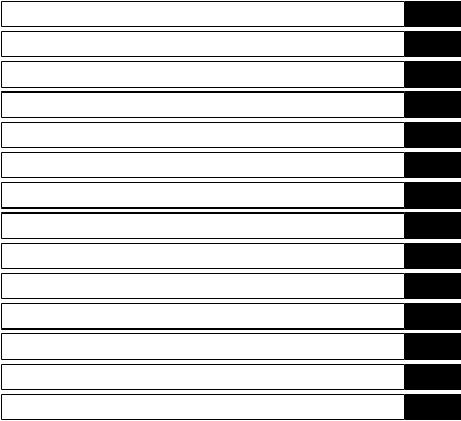
Table of contents
Seat, seatbelt and SRS airbags |
1 |
Keys and doors |
2 |
Instruments and controls |
3 |
Climate control |
4 |
Audio |
5 |
Interior equipment |
6 |
Starting and operating |
7 |
Driving tips |
8 |
In case of emergency |
9 |
Appearance care |
10 |
Maintenance and service |
11 |
Specifications |
12 |
Consumer information and reporting safety defects |
13 |
Index |
14 |
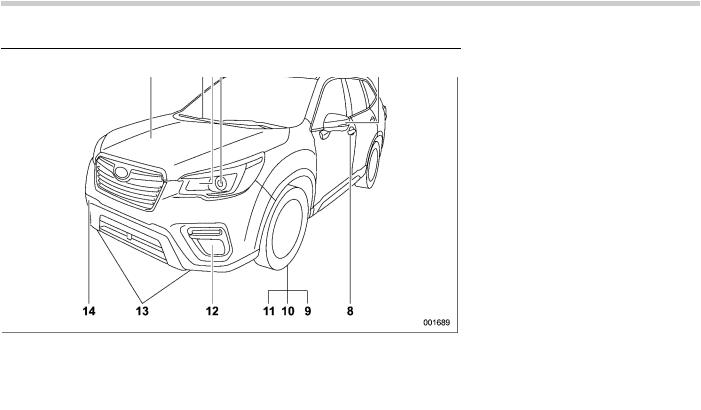
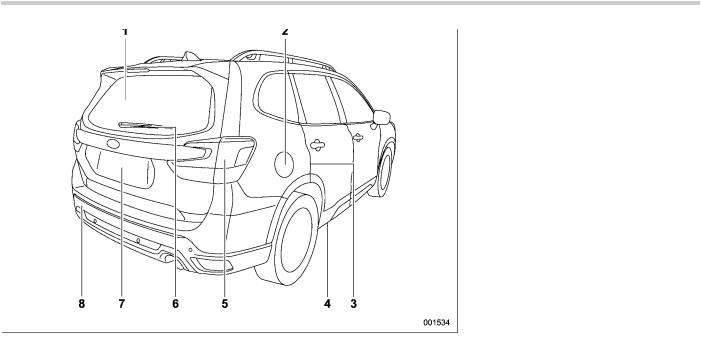
13
1)Rear window defogger (page 253)
2)Fuel filler lid and cap (page 298)
3)Child safety locks (page 139)
4)Tie-down hole (page 431)
5)Replacing bulbs (page 484)
6)Rear window wiper (page 242)
7)Rear gate (page 143)
8)Towing hook (page 431)
– CONTINUED –


15
1)Power windows (page 140)
2)Door locks (page 134)
3)Select lever (page 317)
4)USB power supply (page 286)
5)Front power supply socket (page 284)
6)Glove box (page 282)
7)Cup holder (page 282)
8)Center console (page 282)
– CONTINUED –
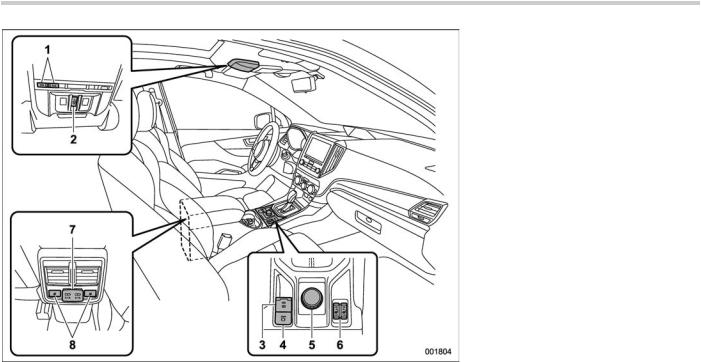
16
1)Button for SUBARU STARLINK
2)Moonroof switch (page 152)
3)Electronic parking brake switch (page 339)
4)Auto Vehicle Hold switch (page 341)
5)X-MODE switch (page 333)
6)Front seat heater switches (page 47)
7)USB power supply (page 286)
8)Rear seat heater switches (page 48)
NOTE
. For U.S.-spec. and Canada-spec. models with SUBARU STARLINK: Refer to the Owner’s Manual supplement for SUBARU STARLINK Safety and Security.
. For models with EyeSight system:
Refer to the Owner’s Manual supplement for the EyeSight system.


18
1)Audio control switches*
2)INFO button for type A multi-function display (black and white) (page 200)/ INFO button for type B multi-function display (color LCD) (page 207)
3)Cruise control switches (page 353)
4)Shift paddle (page 320)
5)SI-DRIVE switches (page 325)
6)Heated Steering Wheel switch (page 255)
7)SRS airbag (page 75)
8)Horn (page 256)
9)Combination meter display control switches (page 191)
10)Talk switch for voice command system*/ Hands-free phone switches*
*: For details about how to use the switches, refer to the separate navigation/audio Owner’s Manual.
NOTE
For models with EyeSight system: Refer to the Owner’s Manual supplement for the EyeSight system.


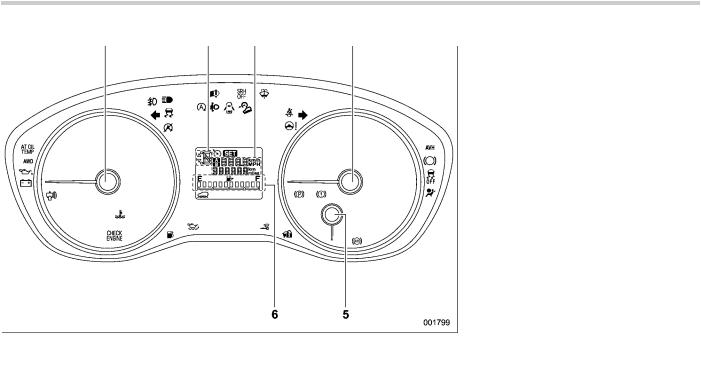
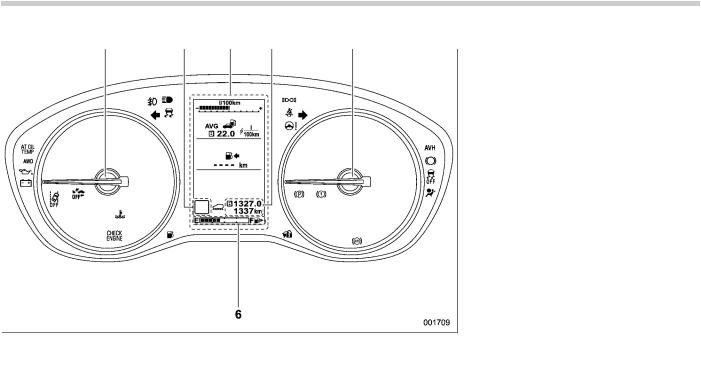

23
– CONTINUED –

24
& Warning and indicator lights
|
|
S00AE06 |
|
Mark |
Name |
Page |
Mark |
|
Seatbelt warning light |
167 |
|
|
Front passenger’s |
167 |
|
|
seatbelt warning light |
|
|
|
|
|
|
|
SRS airbag system |
169 |
|
|
warning light |
|
|
|
|
|
|
/ |
Front passenger’s |
169 |
/ |
frontal airbag ON indi- |
|||
|
cator |
|
|
/ |
Front passenger’s |
169 |
|
frontal airbag OFF in- |
|
||
|
dicator |
|
|
|
CHECK ENGINE |
170 |
|
|
warning light/Malfunc- |
|
|
|
tion indicator light |
|
|
|
Coolant temperature |
|
|
|
low indicator light/ |
170 |
|
|
Coolant temperature |
|
|
|
|
|
|
|
high warning light |
|
|
|
Charge warning light |
171 |
|
|
Oil pressure warning |
171 |
|
|
light |
|
|
|
|
|
Engine low oil level |
172 |
|
warning light |
||
|
Name
AT OIL TEMP warning light
ABS warning light
Brake system warning light (red)
Electronic parking brake indicator light
Door open warning light
Engine hood open warning light
AWD warning light
Power steering warning light
Auto Vehicle Hold ON indicator light
Auto Vehicle Hold operation indicator light
Depress brake indicator light
Page |
Mark |
Name |
Page |
172 |
|
Vehicle Dynamics |
|
|
Control warning light/ |
178 |
|
|
|
Vehicle Dynamics |
|
|
|
Control operation indi- |
|
174 |
|
cator light |
|
|
Vehicle Dynamics |
|
|
|
|
180 |
|
|
|
Control OFF indicator |
|
175 |
|
light |
|
|
|
|
|
|
|
Turn signal indicator |
187 |
175 |
|
lights |
|
|
|
||
|
|
|
|
|
|
LED headlight warning |
188 |
177 |
|
light (if equipped) |
|
|
|
||
|
|
|
|
|
|
High beam indicator |
187 |
177 |
|
light |
|
|
|
||
|
|
|
|
|
|
High beam assist indi- |
187 |
177 |
|
cator light (if equipped) |
|
|
|
||
|
Automatic headlight |
|
|
|
|
188 |
|
|
|
beam leveler warning |
178light (if equipped) Steering Responsive
|
Headlight warning |
|
177 |
light/Steering Respon- |
188 |
|
sive Headlight OFF in- |
|
dicator light (if equipped)
177 |
|
|
Front fog light indicator |
188 |
|
light (if equipped) |
||
|
||
177 |
|

25
Mark Name
Access key warning indicator light (if equipped)
Security indicator light
Sport (S) mode indicator (if equipped)
Intelligent (I) mode indicator (if equipped)
Sport Sharp (S#) mode indicator (if equipped)
Headlight indicator light (if equipped)
Cruise control indicator light (if equipped)
Cruise control set indicator light (if equipped)
X-MODE indicator light (if equipped)
Hill descent control indicator light (if equipped)
Low fuel warning light
Page |
Mark |
Name |
|
|
Low tire pressure |
180warning light (U.S.-spec. models)
185Windshield washer fluid warning light
Auto Start Stop warn-
186ing light/Auto Start
Stop OFF indicator light (yellow)
186Auto Start Stop indicator light (green)
Auto Start Stop No 186 Activity Detected indi-
cator light
188BSD/RCTA warning light (if equipped)
187BSD/RCTA OFF indicator light (if equipped)
188RAB warning light (if equipped)
RAB OFF indicator
189 |
light (if equipped) |
|
|
||
|
Driver Monitoring Sys- |
|
|
tem operation indicator |
|
|
light (green) (if |
|
189 |
equipped) |
|
Driver Monitoring Sys- |
||
|
||
|
tem warning light (yel- |
|
177 |
low) (if equipped) |
|
|
Page |
Mark |
Name |
|
|
Driver Monitoring Sys- |
173tem OFF indicator light (if equipped)
Driver Monitoring Sys-
172tem temporary stop indicator light (if
equipped)
188Icy road surface warning light (if equipped)
189
189
190
190
190
190
190
190
 Page
Page
190
190
190

26
Function settings
S00AF
& Function settings and adjustments on the combination meter display (color LCD)
S00AF01
If your vehicle is equipped with a combination meter display (color LCD), setting adjustments to the following items can be manually changed within the display to meet your personal requirements.
NOTE
. If your vehicle is not equipped with a combination meter display (color LCD), setting changes to the following items will need to be performed by a SUBARU dealer. Refer to “Function settings and adjustments performed by a dealer” FP29.
. For setting adjustments to the following items, refer to the appropriate page for details.
|
Item |
|
1st menu/vehicle |
2nd menu/adjustable ve- |
3rd menu/selectable ve- |
system |
hicle system setting |
hicle system setting |
|
Welcome Screen |
— |
|
Good-bye Screen |
— |
|
Gauge Initial Movement |
— |
Screen Settings |
Units |
— |
|
Tire Pressure Units*1 |
— |
|
Languages |
— |
Available settings |
Factory default setting |
Page reference for |
|
the vehicle system |
|||
|
|
operation |
|
On/Off |
On |
192 |
|
On/Off |
On |
192 |
|
On/Off |
On |
165 |
|
km, km/h, Liter/mile, |
U.S.-spec models: mile, |
|
|
MPH, Gallon |
199 and 205 |
||
MPH, Gallon |
Other models: km, km/h, |
||
|
|||
|
Liter |
|
|
kPa/PSi |
PSi |
195 |
|
English/Español/Fran- |
U.S.-spec models: Eng- |
205 |
|
lish |
|||
çais |
|||
Other models: Français |
|
||
|
|
